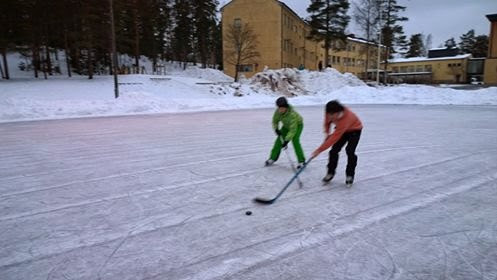
Esperar un nen sempre és una alegria per a tota la família, així que els pares sempre han de respondre a un reguitzell de preguntes: serà nen o nena? Per quan l’espereu? Com es dirà?... A Finlàndia, no es necessari fer la última pregunta (em va quedar clar quan ho vaig preguntar per primera vegada i vaig veure la cara dels finesos…) ja que el nom de la criatura es decideix un cop neix. El primers mesos els pares decideixen el nom que li podria quedar bé tenint en compte el comportament, l’aparença física... del nounat!
 Els pares normalment utilitzen un sobrenom per la criatura i quan els familiars
o amics van a visitar el nadó poden suggerir algun nom. El 75 % dels finesos
són membres de l’església Evangèlica Luterana, així que passat uns mesos la família
convida a familiars i amics perquè el
nounat rebi el baptisme. És moment també d’anunciar els noms de la criatura. Normalment
els pares trien dos o tres noms com a nom.
Els pares normalment utilitzen un sobrenom per la criatura i quan els familiars
o amics van a visitar el nadó poden suggerir algun nom. El 75 % dels finesos
són membres de l’església Evangèlica Luterana, així que passat uns mesos la família
convida a familiars i amics perquè el
nounat rebi el baptisme. És moment també d’anunciar els noms de la criatura. Normalment
els pares trien dos o tres noms com a nom.
Normalment, els pares tenen el mateix cognom després de casar- se (avui dia
es pot triar si quedar-se amb el cognom de la dona o l’home), així que el nadó rep
el mateix cognom. Els finesos només tenen un cognom.
Com una coseta tan petita et pot captivar i entendrir-te tant que podries
estar hores i hores mirant-la... que bonica és la vida!!
Gràcies per deixar-me viure aquests moments! :)
------------------------------------

Waiting for the baby to be born is always full of happiness for all the family, so the parents always want to have answers to a lot of questions such as: Will the baby be boy or girl? When the baby will be born? What will be the name of the baby?... In Finland, it is usually not necessary to have the answer to the last question, because the name of the baby has not to be decided when the baby is born. During the first two or three months the parents decide the names that could fit the baby considering the baby’s behavior, physical appearance...
 The parents usually use a nickname
for the new member of the family, and when the relatives or friends go to visit
the baby, they can suggest some names. 75 % of Finns are member of the
Evangelical Lutheran church, so after two or three months the family will
invite the closest relatives and friends for the baby’s christening. In this
event, the priest will announce the names of the baby. Usually the parents
choose two or three first names.
The parents usually use a nickname
for the new member of the family, and when the relatives or friends go to visit
the baby, they can suggest some names. 75 % of Finns are member of the
Evangelical Lutheran church, so after two or three months the family will
invite the closest relatives and friends for the baby’s christening. In this
event, the priest will announce the names of the baby. Usually the parents
choose two or three first names.
The surname is always the same
as the parents’ surname. Usually the parents have the same surname after
getting married, so the children get the same surname. The Finnish people only
have one surname.
As a small baby can captivate
your love, so that you could see her hours and hours... life is beautiful! :)
Thank you for you let me live these moments! :)
Thank you for you let me live these moments! :)















